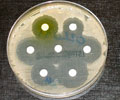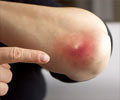
‘Persister cells hide out but also get DNA from other organisms that can give them resistance,” Butzin said. “They’re like sleeper cells—they wait until the antibiotics are gone and start growing again.’
Tweet it Now
She was among the first group of students to participate in the U.S. Department of Agriculture-funded program, which provided qualifying students a 10-week summer laboratory experience at SDSU. In summer 2019, each student will do an industry internship. Associate Professor of Biology and Microbiology Madhav Nepal, who coordinates the program, said “We want to get our students excited about science and agriculture.” Students interested in FAST REEU fellowship can find more information at https://www.sdstate.edu/biology-and-microbiology/fast-reeu-fellowships. Applications are due March 15.
“FAST made me realize I need to figure out what I am doing after graduation,” said Kincade, a microbiology major with a chemistry minor and a member of the Van D. and Barbara B. Fishback Honors College. The Otsego, Minnesota, native transferred to SDSU in fall 2017 after earning an associate degree in veterinary technology at Ridgewater College in Minnesota.
“I am very impressed by Caroline,” said Butzin, who is faculty researcher in the Department of Biology and Microbiology in the College of Natural Sciences. He also does research through the South Dakota Agricultural Experiment Station.
“She’s been a great help in the lab this summer,” added doctoral student Heather Deter, who is studying how changes in the genome allow cells, known as persisters, to gain resistance to antibiotics. “Antibiotic resistance happens because of a change in DNA.”
Advertisement
Once cells are treated, the researchers count the persister cells on each plate. Kincade scanned the plates and then used a computer program Deter created to count the persister cells. “This produces highly accurate quantitative data to understand what’s going on,” said Butzin, whose goal has been to challenge Kincade and thus increase her research skills.
Advertisement
Though she has decided to combine microbiology with veterinary medicine, Kincade will continue to use the skills she learned last summer. “The experience set me up for success,” she added.
Source-Newswise














